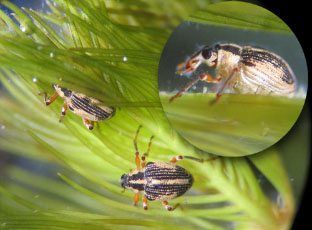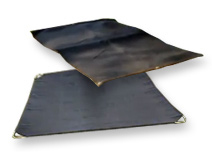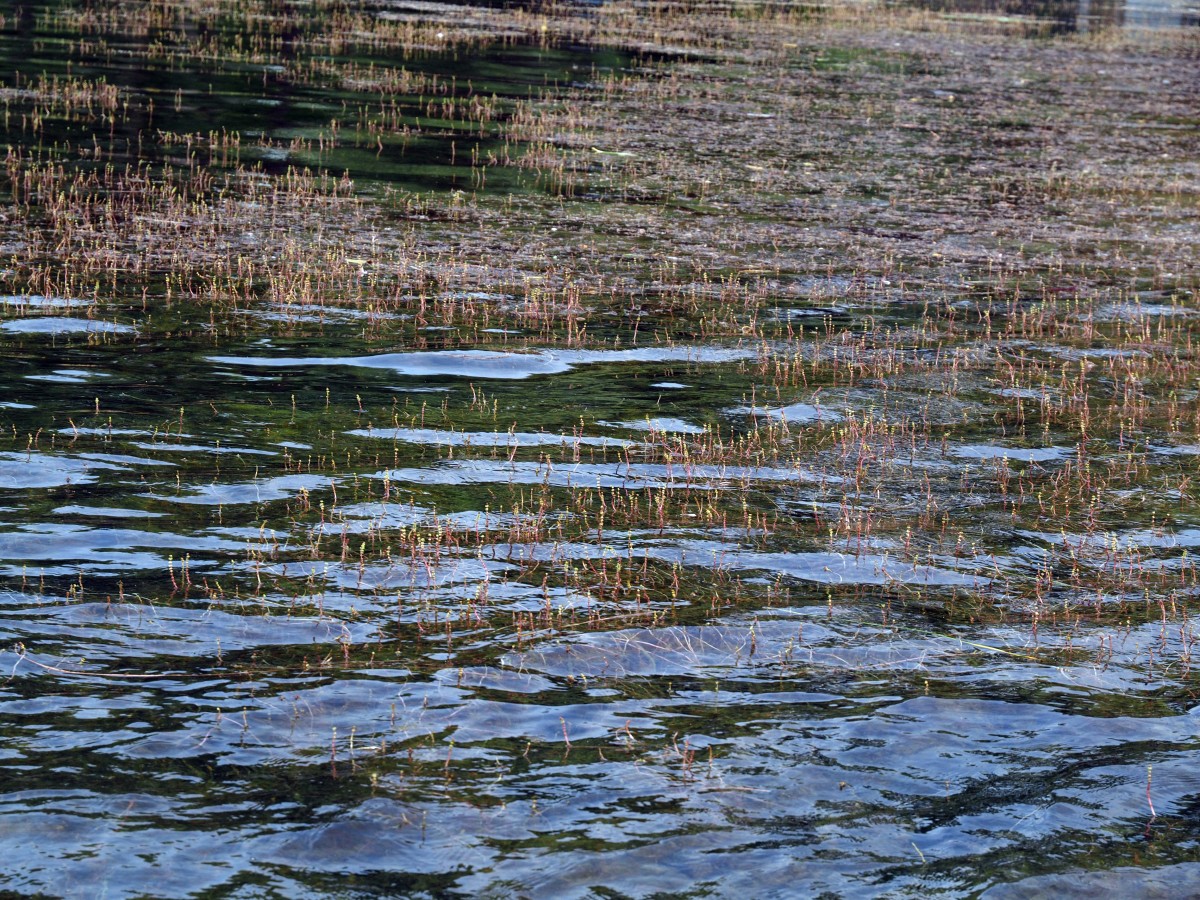Concern is growing over an invasive weed that has taken root in Clark Lake. This weed, the Eurasian Milfoil, has formed a hybrid version that has characteristics of both the native plant and the invader. The invader and the hybrid multiply wildly. One organization comments that the weed takes over a lake “choking out native plants and severely impacting all recreational uses—in many cases, growing so thick that boats are unable to navigate.” DNA testing confirms the weed’s presence in three Clark Lake locations—near the County Park, Hancock Point, and the sandbar at the west side of the lake (in a line between Mud Point and the pineapple). It’s very likely that the invader can found in several other locations around the lake.
To put the threat into perspective, one firm found that a “single piece of fragmented Eurasian milfoil can multiply into 250-million new plants in one year.” It’s been found that this weed can take over a lake in two years. At one lake, the infestations were so thick that ducks were “walking on top of it.”
Recently this website reported on the Clark Lake Clear Water Committee, a group of 11, who surveyed the DNA-confirmed infestations at the County Park and Hancock Point. They then met to discuss options. (You can read about the participants and results of that meeting by clicking here.) Since then, two individuals, Beth June and John Deming, spent many hours researching options to control the weed.
The good news is the early detection of the invader’s arrival. Dealing with it swiftly is the best defense against a problem never faced before at Clark Lake. A summary of the research follows. It includes a brief discussion of each option, noting the pros and cons.
Harvesting
Harvesting Pro
This method temporarily removes the weeds by mechanically cutting them.
Harvesting Con
The harvesting creates clippings. A piece as fine as one leaf is enough to start a new colony. Of all solutions, this is generally recognized as the worst. One fragment can create 250-million new plants in one year.
Weevils

Milfoil weevils (Euhrychiopsis lecontei). Photos courtesy of Tom Alwin and Michigan State University Department of Fisheries and Wildlife
Weevils Pro
This is a biological approach that has shown some success in controlling the Eurasian milfoil and its hybrid. It appears to have little or no negative impact on the environment. Weevils are applied to the infestation where they target Eurasian milfoil. They then feed on the stalk, killing the plant.
Over the course of a summer, there may be several hatchings of these weevils. At the end of the season, the last of the larvae emerges, develops wings, and finds its way to shore and winters there, presuming it can find habitat such as debris.
Weevils Con
Only one firm is known to provide weevils for this purpose–EnviroScience. They are discontinuing production in spring.
The most recent cost was $1.20 per weevil plus shipping. Between 1500 and 2000 weevils are required for each acre of infestation, with reapplication sometimes necessary. The success rate has been mixed. It appears that the use of weevils does not command a sufficient price to warrant the supplier to remain in this business.
There are several reasons for lack of success. One is that the weevil is less effective in lakes that have populations of blue gills and sunfish. Those fish, plentiful in Clark Lake, find the weevil quite tasty.
The supplier has had difficulty with state regulators in shipping the weevils. In order to keep them alive during shipping, they must be accompanied by Eurasian milfoil. When the weevils are applied to the targeted area, they are accompanied by the tagalong Eurasian milfoil.
Mats (seasonal benthic barrier)
 Mats Pro
Mats Pro
Mats offer a mechanical solution that kills off weeds, native and invasive, where applied. The mat blocks the sunlight from reaching the plant which deprives it of photosynthesis, and all weeds under it perish.
Mats Con
Installation and maintenance are key points. If not installed properly, they become navigational hazards to boats and dangerous to wakeboarders and skiers. Mats tend to migrate because of wave action in shallow water. In deeper areas, they may be hooked by fishing lures, dragged by anchors–or in any kind of depth, be open to mischief. Should the mats float off to deeper waters, they may be lost forever.
When mats stay in place, other problems develop. The mats blanket the weeds and trap the rest of the ecosystem below it, killing off whatever is there—good or bad. As the weeds die, the decomposition emits a gas. This gas may balloon the mat and lift it from the bottom and shift its location. A mat, or a piece of it, could rise to the surface or just below it and be hit by a boat or skier. When mats stay in place, silt and muck accumulate on top of the mat, providing a place for vegetation to grow. The first plant to reappear is the Eurasian milfoil and its hybrid.
There are daunting logistical concerns. County Park, a shallow area, is not the only place of infestation. The weed has also been confirmed at the sandbar at the west end of the lake, where the area surrounding the Eurasian milfoil and its hybrid is very deep. Muck and deep water increase the difficulty of laying and maintaining mats.
There are permitting issues. At this point, the DEQ in Jackson is unsure if they would issue a permit. That concern is heightened if the mat is permanent. If it is classified as seasonal (3- months), concern is less. But that creates a logistical responsibility–removing the mats every season. Also they must be cleaned regularly to rid them of accumulated silt and decayed matter. If a mat is not periodically turned over, they become buried, making future turning or moving impossible. This kind of maintenance is a necessary if they are to be effective. So the question–who would be responsible for placement and maintenance on an ongoing basis?
This leads to another concern–cost. To cover all three areas (and there are likely more) would be costly. The Lake Mat Pro has a rigid, weighted frame (48 lbs.) and covers 280 square feet (12 ½ x 24) and costs $359 plus $45 shipping per mat. To cover about one acre, 155 mats would be required at a cost over $62,000. Another product, called the Lake Bottom Blanket, is less expensive, but does not have a rigid frame and appears not to be porous. The 10 x 50 size costs $330 plus $19 shipping. If water cannot freely flow through the fabric, moving or turning it becomes difficult to impossible.
Finally, a manufacturer opined that attempting to cover an area over 1600-square feet would likely fail to be permitted by the DEQ.
Bubblers
Bubblers Pro
At Michigan’s Paradise Lake, bubblers were installed in 400-acres. This cleared the area of Eurasian milfoil where weevils had previously failed.
This is an electro-mechanical solution similar to what is already used at Eagle Point Marine during the winter to keep ice away from their docks. Electrically powered pumps force air through hoses that keep the water in motion.
Bubbles Con
The cost of the Paradise Lake project was high–$200,000. This amount is being defrayed through a mandatory levy on property owners. This solutions tends to work in shallow water where electrical power and other infrastructure support is available. Unlike Paradise Lake, which is primarily shallow, the depths of Clark Lake vary from shallow to deep.
There is a DEQ concern that the widespread use of bubblers could have a harmful effect caused by aeration of the water.
Herbicides
Herbicides Pro
Herbicides are effective. At Clark Lake the arrival of Eurasian milfoil and its hybrid infestation is recent. Because it has not yet covered a large area, it is controllable by spot treatment with herbicides. Designer versions of herbicides target only Eurasian milfoil and its hybrid. The herbicide can be applied early in spring when the good weeds are dormant but the Eurasian milfoil has already started to grow and the lake is used only lightly for recreational purposes. Some products have only a 24-hour swim advisory in the target area, no fish ban, and limited irrigation concerns.
In several ways, this solution offers fewer ecological downsides than some other options. Mats kill all weeds and anything trapped below them and create hazards on the surface. Herbicides do not have the ecological downsides of bubblers–water aeration.
Several lakes in the area use herbicides. Lake Columbia is one of them and employs the services of Professional Lake Management. PLM’s Steven Hansen says that a variety of products are used and selected based on water depth, location and how individual plants have reacted to past treatments. Some of those products are Sonar, Diquat and Renovate. Any product used is designed to target the invader and do not eliminate all weeds. PLM also treats Wamplers Lake where a recent letter to the editor in the Exponent was critical of the results. Hansen’s response was that the program does not kill all weeds, but leaves the good ones in place. He believes that is what some people react to, and points out that some weeds are necessary to keep a lake in proper ecological balance.
Compared to other options outlined in this article, herbicides are cost effective. An example is AccRenovate OTF, manufactured by Sepro. Progressive AE, a water-management consulting firm, estimates using 120 to 200 pounds of the product per acre costs $450 to $750. That cost includes installation by Professional Lake Management.
In considering the safety advisories listed by the manufacturer, it’s important to distinguish if those advisories apply to the installer, residences very close to the spot application, or the lake as a whole. The material safety sheet applies to the installer.
Herbicide Con
Research has proven that the products that are being considered have no negative effects for swimmers, wildlife, fish, etc. However, those who may not take time to read and study the research may still have a negative knee-jerk reaction to this approach and be unalterably opposed.
Conclusion of the Researchers
The research was conducted by two individuals operating independently. Then results were compared to determine if there were discrepancies and to ensure thoroughness. The task included scouring the web, reading and taking notes on reports, and engaging in telephone interviews. Summaries, reports and source links can be found by clicking here.
The researchers, and some others, were initially most attracted to biological or mechanical control. As data accumulated, the notion that this problem could be addressed in those ways diminished.
The truth is, Clark Lake potentially faces a big problem, and there is no ideal solution. The researchers emphasize the good news–early detection. They believe with quick action, it can be controlled to the point where it tends to disappear from everyday view. This will only happen if action is taken now and time is not wasted on faulty solutions. Time is of the essence. The researchers suggest that the careful and lawful application of herbicides offers the quickest, most cost effective and least-ecologically intrusive solution. They hope that anyone reading this approaches the topic as they did: by taking time to read and review the research with thoughtful consideration to the severity of the threat and the practical options available.













